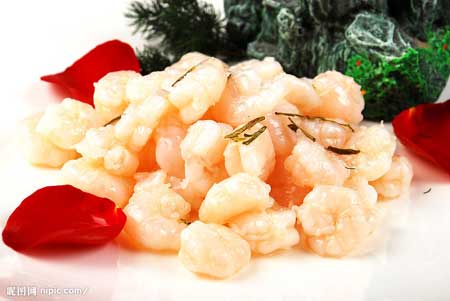Tea, and a table, for two
|
|
|
Longjing prawn Photos: nipic.com |
Rather than swallowing tasteless pills to ward off illness, why not find a prescription that also satisfies the appetite? Sipping antioxidant-rich spring teas is a nice alternative, but comes with the con of frequent visits to the restroom.
That's where cooking with tea comes into play - one still reaps the healthy benefits of the brew, but in a way that's flavorful and filling. Lifestyle presents guidance for how to best eat what's better known as a traditional drink.
Tea for health
Tea is chock-a-block with nutrition; for instance, green tea contains vitamin C. Oolong, as a half-fermented tea, is good for digestion, and its huge dose of theanine, compared to many other teas, helps it to break down the fats in your body. Green tea is said to increase longevity, ward off cancer and reduce inflammation; dishes using it include green tea and tomato soup, a nice food therapy for reducing internal heat on hot days.
"Normally tea is for drinking, while its merits for use as an ingredient are countable," said tea master Xie Siwen. Tea in cooking functions to season food and to reduce greasy flavors, he explained, and "different teas have different flavors as well as medical-like roles." For instance, green tea should be avoided when one has a stomach illness, but red tea can be good for soothing that very problem.
How to incorporate tea in food, then? Little dumplings (xiaolongbao), for example, are filled with chrysanthemum tea to reduce body heat. Note there's a time and place for cooking with tea leaves, and it's never with meat. "Tea is not suitable to eat with meat of any kind," Xie said, "otherwise it might cause constipation." However, using lightly brewed tea water skirts this problem, so some meat dishes that include tea are made using the water alone.
Longjing tea functions as a diuretic and similarly to antibiotics; its theanine content purportedly makes it a good prescription for alleviating symptoms of hepatitis. A popular dish including this tea is longjing prawns. Like longjing, tieguanyin tea also helps eliminate greasy tastes in food, as well as aiding food digestion and purging toxins from the body. A typical Beijing cuisine, tieguanyin short ribs in chestnut soup, is a classic.
Chrysanthemum tea also gets a fair shake in cooking, especially in soups like red jujube. Like the tea itself, this dish may help reduce heat in the body.
There is one side effect of tea (when drinking or eating) not to be overlooked: insomnia. Yes, tea can be used to treat many conditions, but sleeplessness is not one of them.
Now you're cooking with tea
Teas used for cooking include longjing, tieguanyin, jasmine flower, red litchi and chrysanthemum. Fresh-picked tea leaves are the cha of choice in April and May, as that's when they're at their flavor-packed best. Lifestyle has a few recipe suggestions for those who want to give their home-cooked cuisine a healthy spin.
Chrysanthemum hot pot
This hot pot dates back 2,000 years, originally appearing in the royal palace during the Sui and Tang dynasties. Add fish balls, chopped fresh pork or just chicken breast, to a seasoned hot pot soup. Wait until the water boils, then add fresh chrysanthemum flowers broken into pieces. When the meat changes color, the golden soup is ready. Depending on which meat is used, the chrysanthemum gives this dish an appetizingly fresh flower flavor.
Jasmine flower tea
Xiaolongbao with jasmine flower tea exemplifies tea's use in cuisine. The addition of fresh tea water neutralizes the greasiness of the juicy pork. Steep dry flower tea in hot water for 15 minutes; the tea water (not the tea leaves) is then mixed with pork meat and stuffed into dumplings before cooking. There is no need to worry that the tea flavor will overwhelm the dish; the two balance each other, according to Ku, who additionally advises, "For any tea dishes, try not to use things like garlic and green onions with dominating flavors."
 0
0 









Go to Forum >>0 Comments